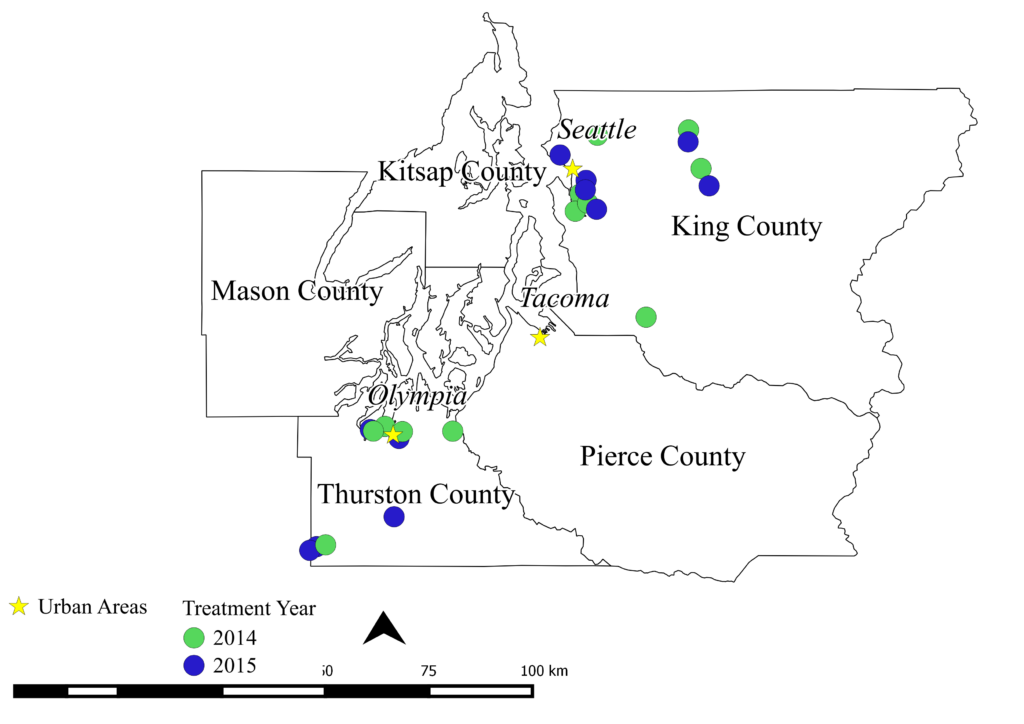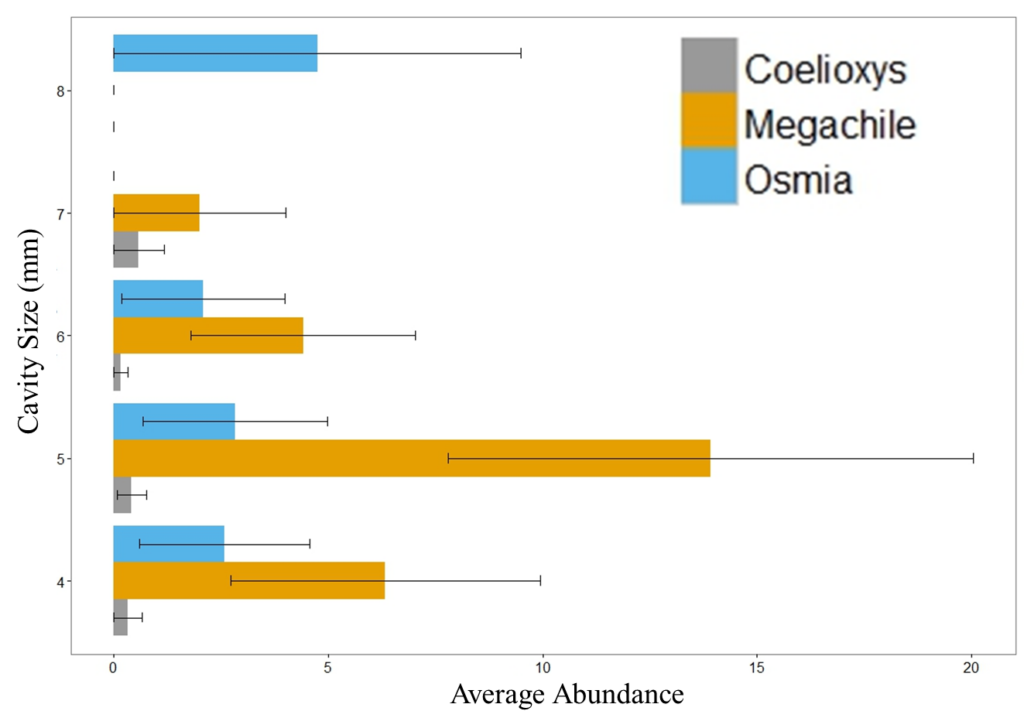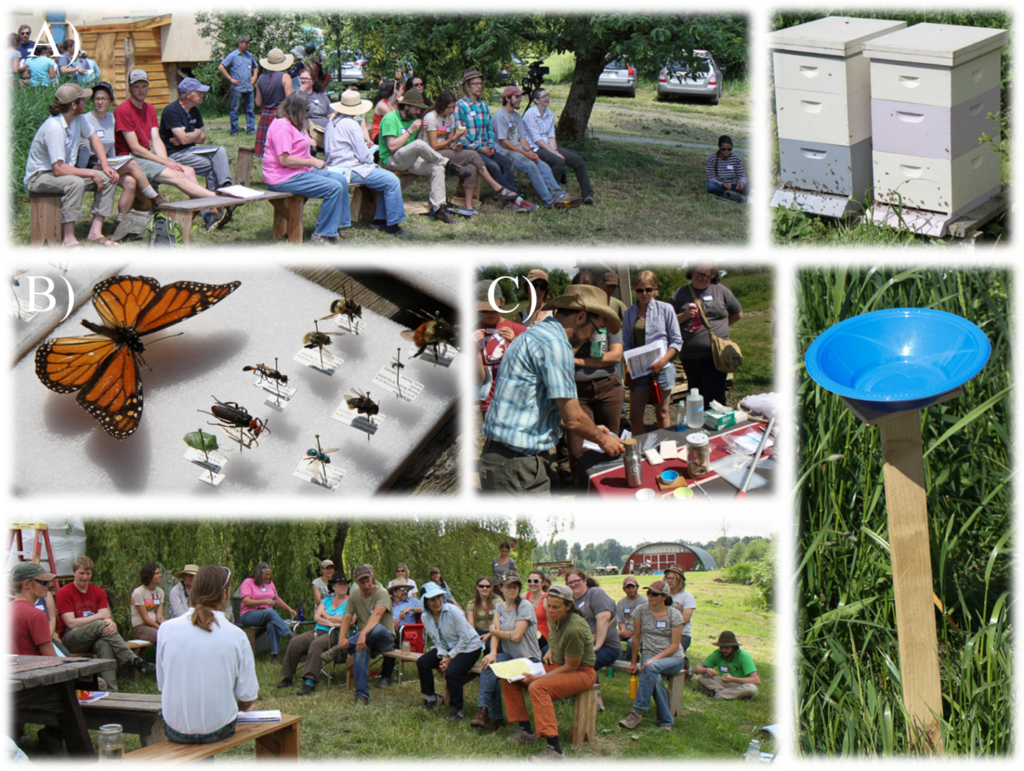2015 Annual Report for GW15-022
Promoting Native Bee Health and Pollination Services on Diversified Organic Produce Famis
Summary
The overall goal of our project is to evaluate the impact of habitat augmentation on native bee community health and pollination services on diversified organic produce farms. To accomplish this, we introduced habitat augmentation on paired diversified organic farms throughout western Washington. At each farm, we sampled bee communities and collected data on pollination services. We developed baseline data for these farming systems in 2014 and added to these data in 2015. Moreover, we engaged the community through citizen science and grower-led field days and launched a website.
Objectives/Performance Targets
(1) Determine if habitat augmentation expedites the development of abundant, diverse, and stable native bee communities
(2) Measure the impact of habitat augmentation on bee communities and pollination services
(3) Educate farmers and engage community members on native bee conservation
Accomplishments/Milestones
- Measured bee communities on 24 farms 3×
- Measured bee-plant visitation on 24 farms 3×
- Determined habitat for 3 genera of cavity-nesting bees
- Developed educational materials for growers 2×
- Conducted field days for growers 3×
- Hosted citizen science events 8×
- Launched our website (www.nwpollinators.org)
Impacts and Contributions/Outcomes
Objective 1 – Determine if habitat augmentation expedites the development of abundant, diverse, and stable native bee communities
Methods: Habitat augmentation in the form of cavity-nesting structures was installed in a cross-over experiment in 2014 and 2015 at 24 farms and urban gardens in the Puget Sound Region (Figure 1). Cavity occupancy was recorded by counting the number of capped cavities in May, July, and September. Visitation rates were also measured using 15-minute observations of bee visits to nesting structures. Cavity nests were collected in November 2014 and 2015 and stored in an incubator under field-realistic climate conditions. Incubated bees emerged into catchments, were stored in alcohol, pinned, and identified to genus. Bee communities were examined using a set of standardized procedures, including bee bowls, blue vane traps, and netting. These bees were stored in alcohol, pinned, and identified to genus.
Results and Discussion: Nesting structures provided habitat for 3 genera of cavity-nesting bees (Figure 2), including a kleptoparasitic bee and non-bee nest parasites. Greater than 5,100 specimens have been collected and will be used to characterize the bee communities of these farming systems. It remains unclear whether cavity-nesting structures impact the bee communities found within the organic farms or the pollination services these bees provide.
Work this Coming Year: All bees and non-bee parasites collected from cavity-nesting structures in 2014 will be identified to species. Bees collected from nesting structures in November 2015 will emerge under field-realistic conditions in incubators and later be identified to species. This will provide us with a two-year data-set and conclude this experiment. All bees collected with traps and netting in 2014 and 2015 will be identified to species. We plan to publish the results of this study in an entomological or applied ecology journal. This article will contain information on how native bees are influence by farming practices, habitat augmentation, and landscape context.
Objective 2: Measure the impact of habitat augmentation on pollination services
Methods: In May, July, and September of 2015 we characterized the flowering plant community and recorded floral visitation rates by native bees at 24 farms and urban gardens in the Puget Sound Region. The morph of bee was noted, as was the species of plant on which the floral visit occurred. In addition to these observations, we netted individual bees and placed them into tubes of molecular grade ethanol.
Work this Coming Year: We will identify all bees in molecular grade ethanol to species. Pollen found on each bee will be identified to the most fine resolution possible using slide mounts and a light microscope. This analysis will determine the network and intensity of plant-pollinator interactions in these farming systems. We plan to publish the results of this study in an entomological or applied ecology journal. This article will contain information on how pollination services are influenced by farming practices, habitat augmentation, and landscape context.
Objective 3: Educate farmers and engage community members on native bee conservation
Methods: In 2015, we launch two citizen science programs and hosted 3 field days for farmers (Figure 3). Field days for farmers included a: 1) lecture on bee declines; 2) tutorial in microscopic bee identification; and 3) overview of field monitoring practices. Our citizen science programs offered: 1) curriculum on bee identification and monitoring and 2) instruction on the life-history of cavity-nesting bees and cavity-nests for volunteer citizen scientists to take home and monitor.
Results and Discussion: Through these field days and citizen science projects, we engaged over 100 community members in Puget Sound Region. We also launched a website (www.nwpollinators.org) to network these community members together.
Work this Coming Year: In 2016, we will host an additional 3 field days for growers and 12 citizen science events. We expect to engage 110 persons in our citizen science project and will begin collecting data on native bees through our website. We plan to produce 2 educational bulletins from field day and citizen science course content and a journal article on the results of our citizen science initiative.
Figure Appendix:
 Figure 1. Locations of cavity-nesting habitat during period of experiment. Farms were paired, and treatments were applied in a cross-over design by year.
Figure 1. Locations of cavity-nesting habitat during period of experiment. Farms were paired, and treatments were applied in a cross-over design by year.
 Figure 2. Nest preferences for three genera of cavity-nesting bees. Several bee species may account for these trends in cavity-use. Coelioxys is a parasitic bee.
Figure 2. Nest preferences for three genera of cavity-nesting bees. Several bee species may account for these trends in cavity-use. Coelioxys is a parasitic bee.
 Figure 3. Images of a field day for organic farmers. A) Growers listen to a lecture on bee declines. B) Specimens used to demonstrate identification features of pollinators. C) A collaborator demonstrates field monitoring techniques.
Figure 3. Images of a field day for organic farmers. A) Growers listen to a lecture on bee declines. B) Specimens used to demonstrate identification features of pollinators. C) A collaborator demonstrates field monitoring techniques.
Collaborators:
Graduate Student
Washington State University
220 SE Gladstone
Apt #4
Pullman, WA 99163
Office Phone: 4026760138